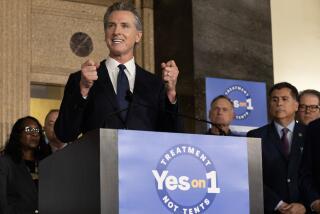DRUG WATCH : Treatment Center
The Clinton Administration’s new $13.2-billion drug initiative, unveiled symbolically at a prison in suburban Washington, signals a much-needed shift of priorities for a national drug policy that had placed too much emphasis on law enforcement and not enough on treatment and education.
Under the plan, announced Wednesday, the share of funds dedicated to treatment and prevention programs will grow by nearly 20%--to $5.4 billion. Monies allocated to combatting drug production at its sources also will increase, in large part at the expense of cross-border anti-smuggling programs, which will be reduced 7.3%.
These changes come at a time when many of the punitive measures advocated fervently by the Bush Administration during its war on drugs are being called into question.
Federal and state prisons are filling up with drug offenders as a result of longer mandatory sentences. In 1980, 4,898 prisoners served time for violating federal drug laws. By 1993 federal prisons were bursting with more than 32,000 drug offenders.
However, those policies failed to substantially affect drug prices or supply. If anything, a recent study of high school students showing increased drug abuse could be a signal that the problem is again on the upswing.
So while the Clinton plan isn’t likely to have a great impact right away, it’s targeting the right areas. With thousands of people already on the waiting list for drug treatment in Los Angeles the new money can’t get here soon enough.
More to Read
Sign up for Essential California
The most important California stories and recommendations in your inbox every morning.
You may occasionally receive promotional content from the Los Angeles Times.









